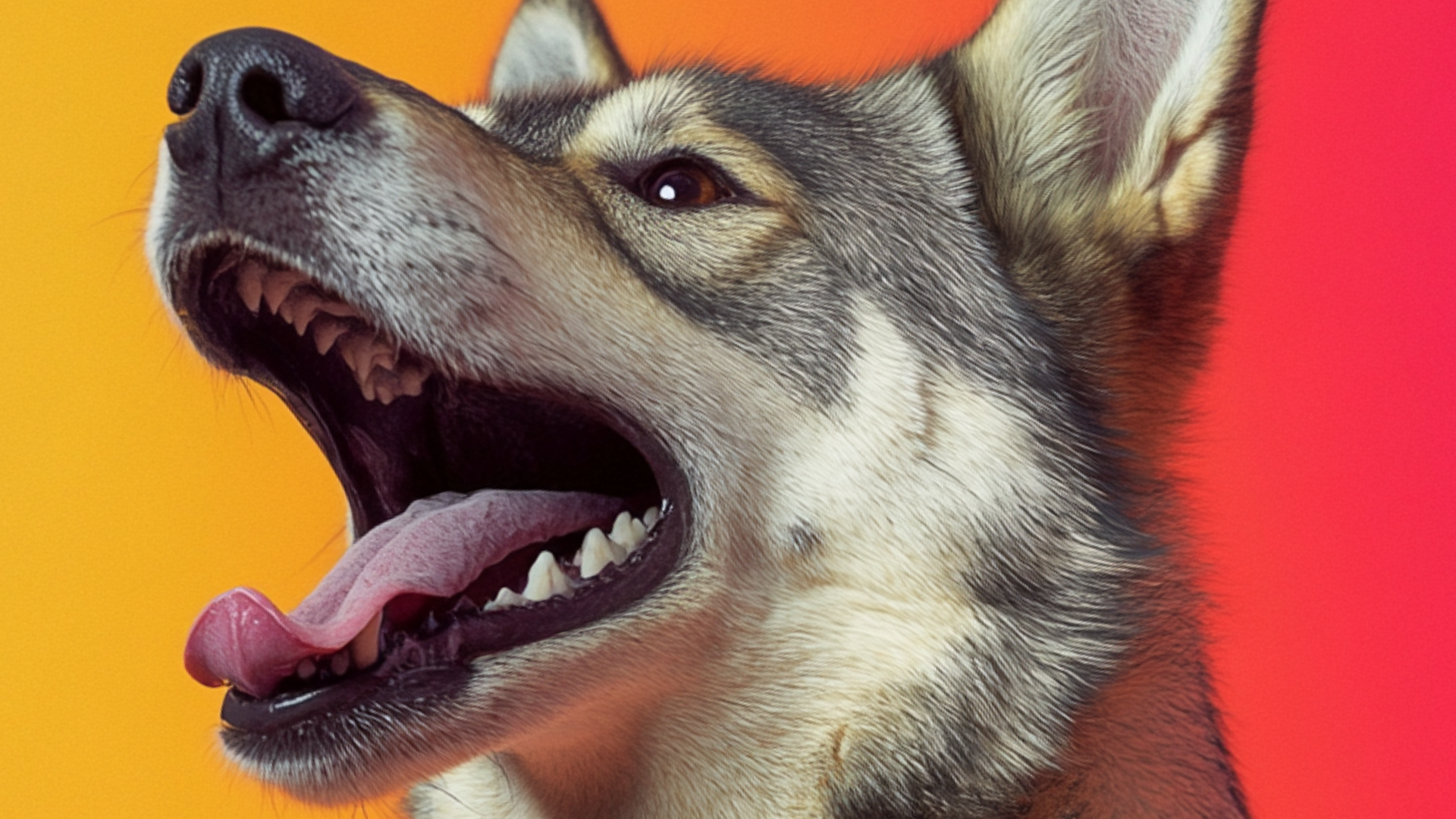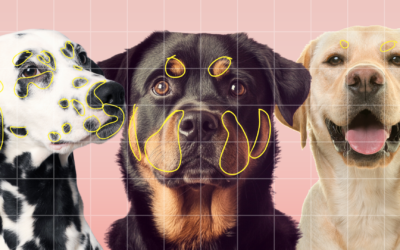Let’s play! How dogs show they want to play
Key message
Relaxed Open Mouth encourages play, often preceding playful offensive behaviours.
It differs from Play Bite, which leads to biting actions.
ROM is a ritualised signal, much like social gestures in other species.
Why this matters

Let’s break down the science
behind the findings
Have you ever watched two dogs interact and wondered, “Are they playing, or is this about to turn into a fight?” The best way to ensure safe and positive dog interactions is to know your own dog and understand the behaviours of the other dogs it interacts with. While every dog has its own unique style of communication, there are universal signals that can reveal their intentions.
Dogs have evolved from wolves, which possess a highly complex communication system. Many of these subtle signals have been inherited by domestic dogs. But how can we be sure what they are communicating? The study by Maglieri and colleagues is a fascinating example of how science allows us to “ask” dogs, “What are you really saying?” Using the scientific method, researchers can decode dog language—let’s see how they did it.
How they studied play expressions in domestic dogs
This study focused on 24 Czechoslovakian Wolfdogs. But why this breed? While they are domesticated dogs, Czechoslovakian Wolfdogs originated from a hybridisation between German Shepherds and Carpathian Wolves in the 1950s. They retain strong wolf-like facial markings, making it easier to study their expressions. Additionally, they have distinct play behaviours and a high degree of social interaction with their own kind.
Researchers recorded video footage of 24 individuals (12 males and 12 females) between the ages of 3 to 78 months. To ensure natural interactions, the study only included dogs with little to no formal training and allowed only familiar dyads to interact. They collected 15 hours of footage, focusing on spontaneous play behaviours.
The key behaviours analysed were:
- Relaxed Open Mouth (ROM): A facial expression where the dog’s mouth remains open, revealing both upper and lower teeth, with lip corners pulled backwards and ears also moving back.
- Play Bite (PBIT): An action where a dog opens its mouth and then quickly closes it in the direction of a playmate, mimicking a bite.
To analyse facial expressions, researchers used DogFACS, a scientifically validated system that identifies and categorises dog facial movements. By comparing ROM and PBIT expressions with neutral facial expressions, they detailed the specific muscle movements involved.
Additionally, they assessed the nature of play interactions, measuring:
- Familiarity between the play partners
- Asymmetry or symmetry in play behaviours (Did one dog dominate, or was the play balanced?)
- The sequence of behaviours following each ROM and PBIT
A complex sequential analysis was conducted to determine what behaviours tended to follow ROM and PBIT expressions—providing insight into whether ROM truly serves as a play signal.
What researchers discovered about play expressions
Relaxed Open Mouth is a true signal
ROM was consistently associated with distinct facial movements, including nose wrinkling, upper lip raising, lower lip depression, and ears pulled back. Unlike the PBIT, ROM was stereotyped, meaning it always appeared in the same recognisable form. This suggests that ROM has evolved as a formalised signal to communicate a specific intent.
ROM means “Let’s Play!”
The study found that when dogs displayed ROM, they were more likely to engage in play behaviours rather than neutral or aggressive actions. The expression often preceded playful offensive behaviours, indicating that ROM functions as a clear “let’s play” signal, rather than an intent to bite.
Evolutionary insights
The findings suggest that ROM has undergone ritualisation, meaning it has evolved into a distinct, exaggerated signal separate from its original function (biting). Similar ritualised signals exist in other species, such as:
- Intrasexual ritualised fighting
- Courtship food offering
- Lip-smacking in primates (derived from chewing and grooming behaviours)
Is ROM only found in czechoslovakian wolfdogs?
While the study focused on this breed, the ROM expression is likely present in all domestic dogs. However, more research is needed to confirm its presence across different breeds and social contexts.
Put the science into practice
How to apply these findings in real life
For dog professionals, researchers, and informed dog guardians, recognising the Relaxed Open Mouth (ROM) can enhance your ability to assess and guide canine interactions with greater precision. Here’s how you can apply these findings:
Observe facial expressions during play
Watch closely when dogs engage in play — especially before any rough-and-tumble action begins. If you see the Relaxed Open Mouth, note the context:
-
Is it followed by playful behaviours such as bouncy movements, play bows, or loose body posture?
-
Does the ROM occur without escalation into biting or tension?
Film short play sequences and review them in slow motion. You’ll often spot subtle expressions that go unnoticed in real time.
Integrate ROM into behaviour assessments
You can include ROM as a marker when evaluating dog-dog compatibility or social skills. Dogs who consistently use ROM — and respond appropriately to it — may be better suited for group play or social environments like daycare.
Use ROM to:
-
Identify socially competent dogs
-
Detect early signs of tension (absence of ROM combined with Play Biting may indicate poor play skills or brewing conflict)
-
Guide interventions before play turns problematic
Support emotionally balanced play
By understanding that ROM is a ritualised, non-aggressive signal, owners and professionals alike can:
-
Avoid misinterpreting open-mouth play as threatening
-
Intervene less often when dogs are play-fighting in a healthy, reciprocal manner
-
Allow more freedom while still ensuring safety
Cite this paper summary as:
Dogs and Science (2025): Let’s play! How dogs show they want to play (www.dogsandscience.com)
Publication:
Maglieri, V., Zanoli, A., Mastrandrea, F., & Palagi, E. (2022). The relaxed open mouth is a true signal in dogs: demonstrating Tinbergen’s ritualisation process. Animal Behaviour, 188, 65–74.
Feedback
At dogsandscience, we are always looking for ways to improve and provide the best experience for our customers. Your feedback is incredibly important to us, as it helps us understand what we’re doing well and where we can do better. Whether you have suggestions, comments, or simply want to share your thoughts, we truly appreciate your input. Every piece of feedback helps us grow and serve you better. Thank you for taking the time to share your experience with us!
Downloads
Get the PDF Version of this article:
Sign up and get our free Tool:
You have already signed up to our list? Enter your Passwort below and download the Tool.
Sign up to get your free Tool!
Subscribe to our newsletter to stay updated and get access to our exclusive Download Area.
Don’t miss out on important insights and discoveries about our canine companions!
After you have subscribed, you will receive an e-mail with your access to the download area.
More Content on Social Media:
You have already signed up?
Get our free Tool now.
Enter the passwort we’ve send you in an e-mail or go to the login area where you can download the tool and other free content.



